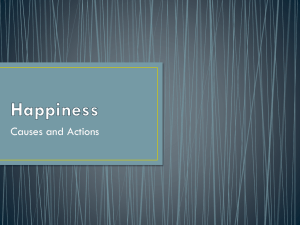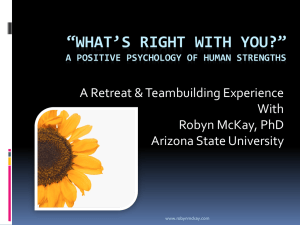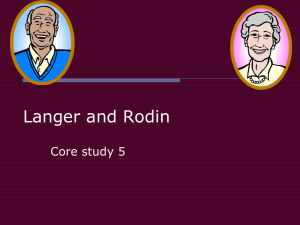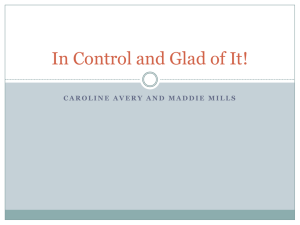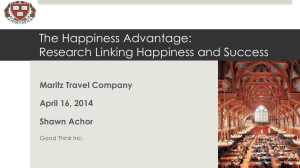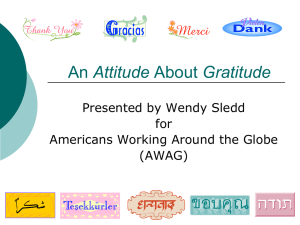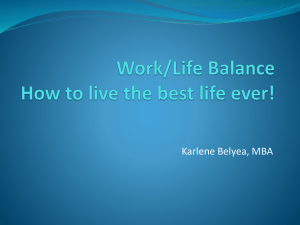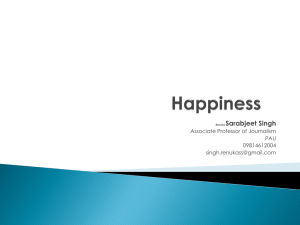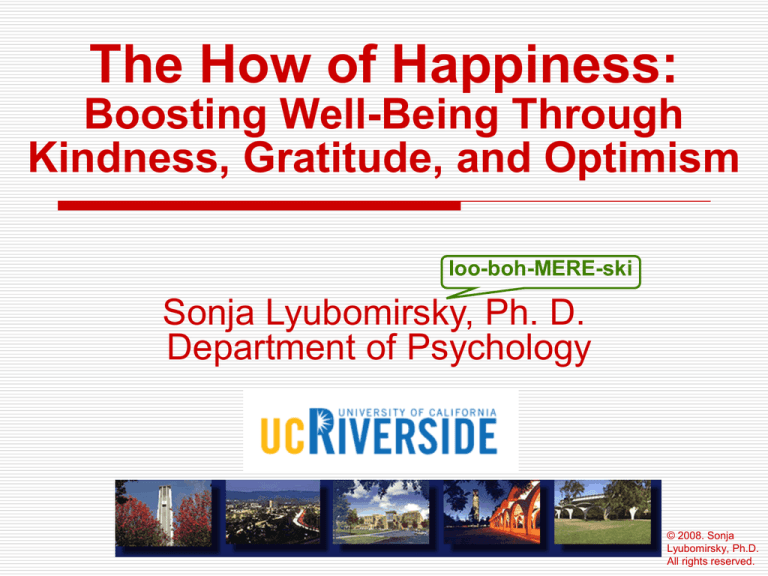
The How of Happiness:
Boosting Well-Being Through
Kindness, Gratitude, and Optimism
loo-boh-MERE-ski
Sonja Lyubomirsky, Ph. D.
Department of Psychology
© 2008. Sonja
Lyubomirsky, Ph.D.
All rights reserved.
The How of Happiness:
Boosting Well-Being Through
Kindness, Gratitude, and Optimism
Collaborators:
Julia Boehm, University of California, Riverside
Rene Dickerhoof, University of California, Riverside
David Schkade, University of California, San Diego
Ken Sheldon, University of Missouri
Chris Tkach, University of California, Riverside
© 2008. Sonja
Lyubomirsky, Ph.D.
All rights reserved.
“Happiness is the meaning
and the purpose of life, the
whole aim and end of
human existence.”
– Aristotle
© 2008. Sonja Lyubomirsky, Ph.D. All rights reserved.
“The purpose of our
lives is to be happy.”
– The 14th Dalai Lama
© 2008. Sonja Lyubomirsky, Ph.D. All rights reserved.
How Important Is Happiness To You?
Importance Rating
7
6
5
4
3
2
1
U.S.
© 2008. Sonja
Lyubomirsky, Ph.D.
All rights reserved.
Greece Germany S. Africa
China
Turkey
How Important Is Happiness To You?
Importance Rating
7
6
5
4
3
2
1
U.S.
© 2008. Sonja
Lyubomirsky, Ph.D.
All rights reserved.
Greece Germany S. Africa
China
Turkey
Is the pursuit of happiness a
worthwhile goal?
In other words, are there
benefits to happiness, or
does it just feel good?
© 2008. Sonja Lyubomirsky, Ph.D. All rights reserved.
225 STUDIES ON THE BENEFITS OF HAPPINESS:
Happy people…
Are more productive at work and more creative
Make more money and have superior jobs
Are better leaders and negotiators
Are more likely to marry and to have fulfilling
marriages, and less likely to divorce
Have more friends and social support
Have stronger immune systems, are physically
healthier, and even live longer
Are more helpful and philanthropic
Cope better with stress and trauma
© 2008. Sonja
FROM: Lyubomirsky, S., King, L. A., & Diener, E. (2005). The benefits of frequent
Lyubomirsky, Ph.D.
positive affect: Does happiness lead to success? Psychological Bulletin, 131, 803-855.All rights reserved.
225 STUDIES ON THE BENEFITS OF HAPPINESS:
Happy people…
Are more productive at work and more creative
Make more money and have superior jobs
Are better leaders and negotiators
Are more likely to marry and to have fulfilling
marriages, and less likely to divorce
Have more friends and social support
Have stronger immune systems, are physically
healthier, and even live longer
Are more helpful and philanthropic
Cope better with stress and trauma
© 2008. Sonja
FROM: Lyubomirsky, S., King, L. A., & Diener, E. (2005). The benefits of frequent
Lyubomirsky, Ph.D.
positive affect: Does happiness lead to success? Psychological Bulletin, 131, 803-855.All rights reserved.
LONGITUDINAL STUDIES
Outcome or
Behavior
Happiness
(Time 1)
(Time 2)
Time
© 2008. Sonja Lyubomirsky, Ph.D. All rights reserved.
WORK PERFORMANCE
STEP 1: Measure how happy employees
are
STEP 2: 3.5 years later, their department
managers rate them on overall work
performance and on these dimensions:
Offers useful ideas
Has high goals for performance
Pays attention to my instructions &
feedback
Works well with others
RESULTS: Happier employees are rated by
FROM: Wright, T. A., & Staw, B. M. (1999). Affect and favorable work outcomes: Two
asworker
superior
on
all dimensions.
longitudinal supervisors
tests of the happy-productive
thesis. Journal of
Organizational
Behavior, 20,
© 2008. Sonja
Lyubomirsky, Ph.D.
All rights reserved.
CREATIVITY
STEP 1: Induce happy mood
STEP 2: Complete a test of creativity
CLUB
GOWN
MARE
____?____
RESULTS: Those in a happy mood
are more creative than those in a
neutral mood.
© 2008. Sonja
FROM: Estrada, C., Isen, A. M., & Young, M. J. (1994). Positive affect improves creative
Lyubomirsky, Ph.D.
All rights reserved.
problem solving and reported source of practice satisfaction in physicians. Motivation and Emotion, 18, 285-299.
PHYSICAL
HEALTH
People who
are happy at one point in
time…
Have a lower incidence of stroke 6 years later
(especially men)
If have coronary heart disease, are more likely
to survive it up to 11 years later
Are less likely to be receiving work disability
pension up to 11 years later
Are less likely to die in a car accident 8 years
later
Are less likely to die of all causes up to 28
years later
FROM: Deeg & van Zonneveld, 1989; Kirkcaldy & Furnham, 2008; Ostir et al., 2001;
Koivumaa-Honkanen et al., 2004; Krause et al., 1997
© 2008. Sonja
Lyubomirsky, Ph.D.
All rights reserved.
“The joyfulness of a man
prolongeth his days.”
– Sirach 3-:22
“A merry heart doeth good like
a medicine: but a broken spirit
drieth the bones.”
– Proverbs 17:22
© 2008. Sonja Lyubomirsky, Ph.D. All rights reserved.
PHYSICAL HEALTH
Healthy volunteers completed a measure
of happiness (or “positive emotional style”)
They were then administered a
rhinovirus (via nasal drops)
Researchers quarantined them for 5 days
and monitored them for 1 month
RESULTS: Happier volunteers were
less likely to develop a cold
© 2008. Sonja
FROM: Cohen, S., Doyle, W. J., Turner, R. B., Alper, C. M., & Skoner, D. P. (2001).
Lyubomirsky, Ph.D.
All rights reserved.
Emotional style and susceptibility to the common cold. Psychosomatic Medicine, 65, 652-657.
QUESTION: Is it possible to
become happier?
And, if it’s possible to
become happier, is it possible
to sustain it?
© 2008. Sonja Lyubomirsky, Ph.D. All rights reserved.
THE SELF-HELP LITERATURE
Happiness Is Free: And It’s Easier Than
Think! (Dwoskin & Levenson, 2002)
You Can Be Happy No Matter What
Happy For No Reason
(Carlson, 1997)
(Shimoff, 2008)
You Can Be the Wife of a Happy Husband
(Cooper, 1977)
© 2008. Sonja Lyubomirsky, Ph.D. All rights reserved.
You
~ Do the 5 principles work?
~ Do some work better than
others?
~ Do they work better for
some people than for
others?
~ Are any positive effects
due to placebo effects?
~ Do the happiness boosts
last?
© 2008. Sonja Lyubomirsky, Ph.D. All rights reserved.
THREE REASONS TO BE PESSIMISTIC
We’re all born with a geneticallydetermined “set point” for happiness
© 2008. Sonja
Lyubomirsky, Ph.D.
All rights reserved.
THREE REASONS TO BE PESSIMISTIC
We’re all born with a geneticallydetermined “set point” for happiness
Happiness is a life-long trait
© 2008. Sonja Lyubomirsky, Ph.D. All rights reserved.
THREE REASONS TO BE PESSIMISTIC
We’re all born with a geneticallydetermined “set point” for happiness
Happiness is a life-long trait
“Hedonic adaptation”: We adapt to all
things positive
© 2008. Sonja Lyubomirsky, Ph.D. All rights reserved.
My argument:
Despite the fact that our happiness is
partially genetically determined and
despite the fact that our life situations
have a minimal influence on how happy
we are, still a very large portion of
happiness – up to 40% – is in our
power to change.
© 2008. Sonja Lyubomirsky, Ph.D. All rights reserved.
WHAT DETERMINES
HAPPINESS?
Set Point
50%
FROM: Lyubomirsky, S., Sheldon, K. M., & Schkade, D. (2005). Pursuing
© 2008. Sonja
happiness: The architecture of sustainable change. Review of General Psychology, 9, Lyubomirsky,
111-131. Ph.D.
All rights reserved.
WHAT DETERMINES
HAPPINESS?
Circumstances
10%
Intentional
Activity
40%
Set Point
50%
FROM: Lyubomirsky, S., Sheldon, K. M., & Schkade, D. (2005). Pursuing
© 2008. Sonja
happiness: The architecture of sustainable change. Review of General Psychology, 9, Lyubomirsky,
111-131. Ph.D.
All rights reserved.
DEFINING HAPPINESS
Experience of frequent positive emotions
AND a sense that one’s life is good
Researchers let people judge their
happiness for themselves
Happiness is subjective
© 2008. Sonja Lyubomirsky, Ph.D. All rights reserved.
RESEARCH SHOWS THAT HAPPY
PEOPLE:
Nurture and enjoy their social relationships
Are comfortable expressing gratitude
Are often the first to help others
Practice optimism about the future
Savor pleasures and live in the present moment
Make physical activity a habit
Are often spiritual or religious
Are deeply committed to meaningful goals
© 2008. Sonja
FROM: Lyubomirsky (2001); Diener et al. (1999); Myers (2000), Diener & Lucas (1999), Lyubomirsky, Ph.D.
All rights reserved.
Argyle (1999)
RESEARCH SHOWS THAT HAPPY
PEOPLE:
Nurture and enjoy their social relationships (relevant to
hobbies -- e.g., interacting/working with others)
Are often the first to help others (relevant to hobbies)
Savor pleasures and live in the present moment
(relevant to hobbies -- e.g., “flow”)
Make physical activity a habit (relevant to hobbies)
Are often spiritual or religious (relevant to hobbies)
Are deeply committed to meaningful goals (relevant to
hobbies -- e.g., learning new things, pursuing new projects)
© 2008. Sonja
Lyubomirsky, Ph.D.
All rights reserved.
INTENTIONAL POSITIVE ACTIVITY
Behavioral: How we act
Cognitive: How we think
Motivational: What goals we follow
© 2008. Sonja Lyubomirsky, Ph.D. All rights reserved.
People adapt to almost all positive
experiences.
Adaptation to positive experiences
is one of the greatest obstacles to
raising happiness.
My goal: To determine how we can
thwart or slow down such
adaptation.
© 2008. Sonja Lyubomirsky, Ph.D. All rights reserved.
ADVANTAGES OF ACTIVITY
Variety: You can vary it
“To be interested in the changing seasons is a happier state of
mind than to be hopelessly in love with spring.”
— George Santayana
© 2008. Sonja
Lyubomirsky, Ph.D.
All rights reserved.
ADVANTAGES OF ACTIVITY
Variety: You can vary it
Timing: You can time it
Surprise: You can generate surprises
Attention: You can try to hold it in your
mind and appreciate it
© 2008. Sonja
Lyubomirsky, Ph.D.
All rights reserved.
“My experience is what
I agree to attend to.”
– William James,
“father” of psychology
© 2008. Sonja Lyubomirsky, Ph.D. All rights reserved.
ADVANTAGES OF ACTIVITY
Variety: You can vary it
Timing: You can time it
Surprise: You can generate surprises
Attention: You can try to hold it in your
mind and appreciate it
FROM: Lyubomirsky, S. (2008). Surmounting a critical barrier to becoming happier: Hedonic
adaptation to positive experience. To appear in S. Folkman (Ed.), Handbook on stress,
coping,
© 2008. Sonja
Lyubomirsky, Ph.D.
All rights reserved.
Intervention: An experiment in
which people are instructed to
change themselves in some way
that has a positive outcome.
© 2008. Sonja Lyubomirsky, Ph.D. All rights reserved.
HAPPINESS INTERVENTIONS WE
HAVE CONDUCTED:
Over the course of 2-3 months, volunteers are
asked to do the following on a regular basis:
Commit acts of kindness
Count their blessings
Write gratitude letters
Visualize their best possible future
Savor and replay happy days
© 2008. Sonja Lyubomirsky, Ph.D. All rights reserved.
The conclusion of our research:
“Happiness takes work!”
© 2008. Sonja Lyubomirsky, Ph.D. All rights reserved.
THREE HAPPINESS-ENHANCING
INTERVENTIONS
Study 1: Committing Acts of Kindness
Study 2: Expressing Gratitude & Optimism
Study 3: Expressing Gratitude & Optimism
Across Cultures
© 2008. Sonja Lyubomirsky, Ph.D. All rights reserved.
THREE HAPPINESS-ENHANCING
INTERVENTIONS
Study 1: Committing Acts of Kindness
Study 2: Expressing Gratitude & Optimism
Study 3: Expressing Gratitude & Optimism
Across Cultures
© 2008. Sonja Lyubomirsky, Ph.D. All rights reserved.
If You Want Happiness…
For an hour — Take a nap
For a day — Go fishing
For a month — Get married
For a year — Inherit a fortune
For a lifetime — Help somebody else
— Chinese Proverb
© 2008. Sonja Lyubomirsky, Ph.D. All rights reserved.
“The benefits of
helping somebody is
beneficial.”
– George W. Bush
© 2008. Sonja Lyubomirsky, Ph.D. All rights reserved.
Kind Acts…
Help us see others and our community more charitably
Prompt us to feel better off by comparison
Relieve distress or guilt over others’ misfortune
Give us a sense of interdependence and cooperation
Lead us to see ourselves as generous, and to feel
confident, competent, in control, and optimistic about our
ability to help
Lead others to like us more and help us make new friends
Increase the chance that others will appreciate us and
reciprocate in our times of need
© 2008. Sonja
Lyubomirsky, Ph.D.
All rights reserved.
Study 1: “Acts of Kindness”
Participants were instructed to do 3 or 9 acts of
kindness per week for a period of 10 weeks
Three groups:
High variety (do any acts out of an original
list of 15) (n = 70)
Low variety (choose 3 acts out of a list of 15
and do them over and over again) (n = 23)
Control (list 3 or 9 events each week) (n = 94)
© 2008. Sonja Lyubomirsky, Ph.D. All rights reserved.
How We Measured Happiness
Subjective Happiness Scale (4 items)
Items include…
In general, I consider myself:
1
2
not a very
happy person
3
4
5
6
7
a very
happy person
6
7
more happy
Compared to most of my peers, I consider myself:
1
less happy
2
3
4
5
© 2008. Sonja Lyubomirsky, Ph.D. All rights reserved.
How We Measured Happiness
Terrible-Delighted Scale (1 item)
How do you feel about your life right now?
1
terrible
2
3
mixed dissatisfied
and satisfied
© 2008. Sonja Lyubomirsky, Ph.D. All rights reserved.
4
5
delighted
Instructions:
We would like you to list 15 acts of kindness that you would like to do
more in the future. Acts of kindness are acts or behaviors that are not
normally expected of you in your daily life, and involve some sacrifice
by you. Only write down acts of kindness that are easily repeatable
on a daily basis. For example, if you live with someone, the act of
kindness could be doing a chore that you don't usually do. If you go to
a coffee shop or stand in a line every day, the act could be letting one
person go ahead of you in line. If you drive every day, the act of
kindness could be letting a car enter your lane or go ahead of you at
a stop sign, etc. After you make your list, we ask you to choose 3 [9]
of these acts and do them during the upcoming week.
© 2008. Sonja Lyubomirsky, Ph.D. All rights reserved.
Changes in Subjective Happiness
Subjective Happiness Level
5.4
High Varie ty
5.2
Control
Low Variety
5
4.8
4.6
4.4
4.2
Before
Study
MidStudy
© 2008. Sonja Lyubomirsky, Ph.D. All rights reserved.
After
Study
1-Month
Later
Theme of my research:
“Fit” is critical.
~ Fit with your personality
~ Fit with your goals
~ Fit with your strengths
~ Fit with your lifestyle
~ Fit with the source of your
unhappiness
© 2008. Sonja Lyubomirsky, Ph.D. All rights reserved.
THREE HAPPINESS-ENHANCING
INTERVENTIONS
Study 1: Committing Acts of Kindness
Study 2: Expressing Gratitude & Optimism
Study 3: Expressing Gratitude & Optimism
Across Cultures
© 2008. Sonja Lyubomirsky, Ph.D. All rights reserved.
Study 2: “Gratitude and Optimism”
Participants were instructed to write for 15 min
per week over the course of 8 weeks
Conditions:
Expressing Optimism: Write about your best
possible future selves (n = 113)
Expressing Gratitude: Write letters of
gratitude (n = 109)
Control: List what you have done over the
past 7 days (n = 110)
© 2008. Sonja Lyubomirsky, Ph.D. All rights reserved.
OPTIMISM CONDITION
Instructions
Please take a moment to think about your romantic life
in the future (say in 10 years). Imagine that everything
has gone as well as it possibly could for you. You have
an amazing partner or wife/husband and everyone is
impressed by the relationship you share. Think of this
as the realization of all your hopes and expectations
regarding a significant other. Now, for the next 15 min,
write about what you imagined.
© 2008. Sonja Lyubomirsky, Ph.D. All rights reserved.
GRATITUDE CONDITION
Instructions
Please take moment to think back over the past several years of
your life and remember an instance when someone did something
for you for which you are extremely grateful. For example, think of
the people – parents, relatives, friends, teachers, coaches,
teammates, employers, and so on – who have been especially
kind to you but have never heard you express your gratitude.
Although you should try to write your letter of gratitude to a new
person each week; if you prefer, you can write another letter to the
same person you wrote to previously. Now for the next 15 min,
write a letter to one of these individuals.
© 2008. Sonja Lyubomirsky, Ph.D. All rights reserved.
Testing the Role of Motivation
Participants recruited into a “high
motivation” vs. “low motivation” group
“Do you want to
become happier?
Sign up here to learn
more…”
“This study is about
practicing cognitive
exercises. Sign up
here to learn more…”
© 2008. Sonja Lyubomirsky, Ph.D. All rights reserved.
2X3 Design (6 groups)
Optimism
Gratitude
Control
Motivated
n = 80
n = 78
n = 75
NonMotivated
n = 33
n = 31
n = 35
© 2008. Sonja Lyubomirsky, Ph.D. All rights reserved.
2X3 Design (6 groups)
Optimism
Gratitude
Control
Motivated
n = 80
n = 78
n = 75
NonMotivated
n = 33
n = 31
n = 35
© 2008. Sonja Lyubomirsky, Ph.D. All rights reserved.
Changes in Happiness
Changes in Happiness
Immediately After the Intervention
0.05
0
-0.05
-0.1
-0.15
-0.2
Nonmotivated
Motivated
© 2008. Sonja
Lyubomirsky, Ph.D.
All rights reserved.
Changes in Happiness
Changes in Happiness
9-Month Follow-Up
0.05
0
-0.05
-0.1
-0.15
-0.2
Nonmotivated
Motivated
© 2008. Sonja
Lyubomirsky, Ph.D.
All rights reserved.
Changes in Happiness
Immediately After the Intervention
Changes in Happiness
0.15
0.1
0.05
0
Not
Motivated
Not
Motivated
Motivated
Motivated
-0.05
-0.1
-0.15
Optimism
Gratitude
© 2008. Sonja
Lyubomirsky, Ph.D.
All rights reserved.
Changes in Happiness
9-Month Follow-Up
Changes in Happiness
0.2
0.15
Not
Motivated
0.1
0.05
Not
Motivated
0
Motivated
-0.05
-0.1
Motivated
-0.15
-0.2
Optimism
Gratitude
© 2008. Sonja
Lyubomirsky, Ph.D.
All rights reserved.
The Role of Effort
0.15
High Effort
Low Effort
0.05
-0.05
-0.15
Optimism
Gratitude
Control
© 2008. Sonja
Lyubomirsky, Ph.D.
All rights reserved.
0.15
The Role of “Fit”
0.1
High Fit
0.05
Low Fit
0
-0.05
-0.1
-0.15
Optimism
Gratitude
Control
© 2008. Sonja
Lyubomirsky, Ph.D.
All rights reserved.
Our findings attest to the
important role of motivation,
effort, commitment, and fit.
© 2008. Sonja Lyubomirsky, Ph.D. All rights reserved.
THREE HAPPINESS-ENHANCING
INTERVENTIONS
Study 1: Committing Acts of Kindness
Study 2: Expressing Gratitude & Optimism
Study 3: Expressing Gratitude & Optimism
Across Cultures
© 2008. Sonja Lyubomirsky, Ph.D. All rights reserved.
Our hypothesis:
The pursuit of happiness is
universal. Thus, both AsianAmericans and AngloAmericans will benefit equally
(but perhaps differently) from
our happiness interventions.
© 2008. Sonja Lyubomirsky, Ph.D. All rights reserved.
Study 3: “Gratitude and Optimism
Across Cultures”
Participants were instructed to write for 10 min
per week over the course of 6 weeks
Conditions:
Expressing Optimism: Write about your best
possible future selves (n = 78)
Expressing Gratitude: Write letters of
gratitude (n = 80)
Control: List what you have done over the
past 7 days (n = 81)
© 2008. Sonja Lyubomirsky, Ph.D. All rights reserved.
Again a 2 X 3 Design
Optimism
Gratitude
Control
AngloAmericans
n = 36
n = 41
n = 40
AsianAmericans
n = 42
n = 39
n = 41
© 2008. Sonja Lyubomirsky, Ph.D. All rights reserved.
Comparing Our Two Ethnic Groups
ANGLO-AMERICANS (N = 117)
% Female
Mean Age
% Married
% College Graduate
% >$60,000/year
% Not religious 20%
47%
39
59%
65%
48%
ASIAN-AMERICANS (N = 122)
% Female
Mean Age
% Married
% College Graduate
% >$60,000/year
% Not religious
Born in:
China
56%
31
37%
97%
48%
23%
41%
Taiwan
14%
Vietnam
13%
S. Korea
7%
Hong Kong 4%
India
4%
© 2008. Sonja Lyubomirsky, Ph.D. All rights reserved.
Changes in Well-Being
1-Month Follow-Up
Changes in Well-Being
0.5
0.25
0
-0.25
-0.5
-0.75
Optimism
Gratitude
Control
© 2008. Sonja
Lyubomirsky, Ph.D.
All rights reserved.
Changes in Well-Being
1-Month Follow-Up
0.8
Changes in Well-Being
0.6
0.4
0.2
AngloAmericans
AsianAmericans
0
-0.2
-0.4
-0.6
-0.8
Optimism Gratitude
Control
© 2008. Sonja
Lyubomirsky, Ph.D.
All rights reserved.
Changes in Relationships
During the Second Half of the Intervention
Changes in Relationships
0.3
0.2
0.1
0
-0.1
-0.2
Anglo-Am ericans
Asian-Americans
© 2008. Sonja
Lyubomirsky, Ph.D.
All rights reserved.
Changes in Gratitude
During the Second Half of the Intervention
Changes in Gratitude
0.3
0.2
0.1
0
-0.1
-0.2
Anglo-Am ericans
Asian-Americans
© 2008. Sonja
Lyubomirsky, Ph.D.
All rights reserved.
“We don’t believe in this Robinson
Crusoe happiness. All happiness is
relational.”
– Karma Ura,
director of Centre for
Bhutan Studies
© 2008. Sonja Lyubomirsky, Ph.D. All rights reserved.
WHAT’S NEXT?
More happiness interventions
Do expectations matter?
Does timing matter?
Does social support matter?
Do habits matter?
Why do the strategies work?
© 2008. Sonja Lyubomirsky, Ph.D. All rights reserved.
WHAT’S NEXT?
More happiness interventions
Do expectations matter?
Does timing matter?
Does social support matter?
Do habits matter?
Why do the strategies work?
Can we alleviate depressive
symptoms?
© 2008. Sonja Lyubomirsky, Ph.D. All rights reserved.
PREDICTION: By 2020, depression will be
the second-leading cause of mortality in
the entire world, affecting 30% of all
people.
– World Health
Organization
FROM: Murray, J. L., & Lopez, A. D. (1996). The global burden of disease: A comprehensive
assessment of mortality and disability from diseases, injuries and risk factors in 1990 and
projected
© 2008. Sonja
Lyubomirsky, Ph.D.
All rights reserved.
Question:
Would depressed people benefit more
from happiness interventions?
~because they have more room to improve
Or would they benefit less?
~because their cognitive and behavioral deficits
prevent them from taking full advantage of
the strategies
© 2008. Sonja Lyubomirsky, Ph.D. All rights reserved.
“Happiness
depends upon
ourselves.”
– Aristotle
Website:
www.thehowofhappiness.com
© 2008. Sonja Lyubomirsky, Ph.D. All rights reserved.

